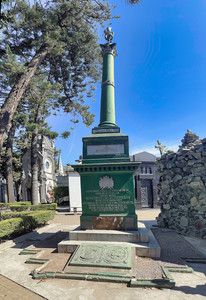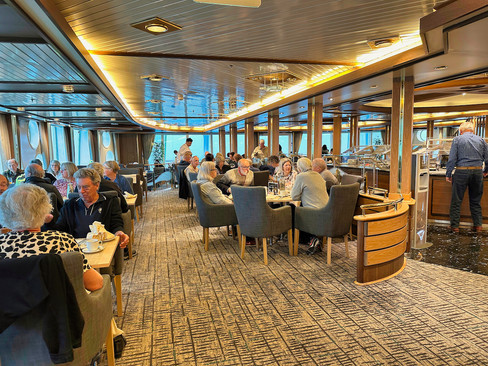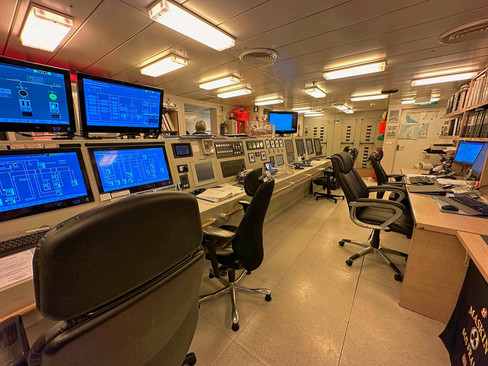
We had to leave Antarctica a day early because of storms forcasted in the seas between the Antarctic peninsula and the tip of South America (Cape Horn), commonly referred to as the Drake Passage. The passage, where the Atlantic, Pacific and Antarctic oceans meet, can vary from smooth water (the "Drake Lake") to quite rough (the "Drake Shake") and which can see swells of up to 40-50 feet. We definitely had the Shake, although talking to some of the crew it could have been a lot worse than it was. Fortunately, seasickness bands and meclizine pills kept Doug's stomach settled, and Jeannette seemed relatively impervious to seasickness.
To avoid the continuing stormy weather, the captain exited the Drake and entered the Beagle Channel, named after the ship that took Charles Darwin on his voyage of discovery. The Beagle Channel, the Straits of Magellan to the north, and the Drake Passage to the south are the three ways to cross between oceans. We arrived back in Chilean waters in the early afternoon on Friday, March 10, but we still had a day's sailing to get to Punta Arenas, winding our way through the southern part of Chili which is a maze of islands. There had been a fresh dusting of snow and many of the islands had glaciers tumbling from their mountain tops to the sea.


We had a beautiful sunset with very interesting ink spot clouds.

Although very overcast, the Beagle Channel was calm through the day and evening, but we had a couple hours of stormy weather again when we reached the Pacific, and could see waves crashing onto the shore and throwing up high curtains of spray. We turned into the Straits of Magellan toward Punta Arenas.
We arrived in Punta Arenas shortly before midnight on Saturday, and departed the Fram on Sunday morning. As buses took us to the airport for a group flight to Santiago, we stopped at a few viewpoints, including a high area with an overview of Punta Arenas and the Straits of Magellan beyond...

...a statue of Ferdinand Magellan himself, and the obligatory Punta Arenas selfie sign.
From Santiago, the Fram's passengers would scatter to their various corners of the world.
We had arranged to stay overnight at the Santiago airport, and Monday morning took a two-hour flight to Buenos Aires, Argentina, the final stop on our trip. We had picked a hotel in the historic area called the Tango de Mayo, which turned out to be on one of the main avenues that linked the main government buildings. The street itself seemed a little run down, with some closed stores and graffiti on the buildings, but because it was a business rather than residential area, it was nice and quiet at night.
The afternoon of our arrival, we walked up and down the Avenue de Mayo and saw some of the main buildings such as the New Congress building (where the legislature meets).

The square in front of it had one of the copies of Rodin's The Thinker, as well as a huge gum tree.
Toward the other end of the avenue was the "Pink House," where the President presides over official functions (he lives in another building about 20 minutes away by helicopter).

The square in front of the Pink House is, supposedly, where Buenos Aires was founded. There is an interesting set of architectural styles on display around the square. Below is a picture of the cathedral (where Pope Francis presided as Cardinal before his elevation to the papacy) built in the style of a greek temple.

Around the corner from it is a building clearly built in French Renaissance style (Buenos Aires is sometimes referred to as the Paris of South America, and it does have a very European feel to it). And right next to that is a building very reminiscent of Spanish colonial architecture in Texas and California.
On the walk back to our hotel, as we crossed the Avenue de 9 Julio (it celebrates Argentina's independence and is super-wide - bigger than Paris' Champs-Élysées) we saw a protest moving down the avenue. The staff at the hotel told us that someone is protesting something almost every day in Buenos Aires. One of the big issues currently is inflation, which is running about 100 percent annually.
Another thing very apparent to us during our walk is that Argentina does not consider ownership of the Falklands/Malvinas a settled issue. We saw one sign on a Federal building with a map of the Falklands and the phrase "Malvinas: We are One," and another building named the Malvinas Heroes building.
That evening we had an amazing dinner at a Argentinian steakhouse called Fervor (Argentina is famous for its beef).
The next day we had a arranged for a private guide to take us on a four hour tour of Buenos Aires. Her name was Ana Speranza, and she was both knowledgeable and full of energy.

To start our tour, Ana took us to the Cementerio de la Recoleta where the rich and famous are buried, using it to give us a mini-lesson in Argentina's history, including its war and independence from Spain in 1816. One of the heros of the war was an Irishman called William Brown, and he has a green edifice in the cemetery.
There was a ceremony honoring one of Argentina's past presidents (a dictator) that day, so we saw lots of honor guards in the fancy uniforms of the different military services.

Peeking into some of the mausoleums you could see how fancy they were inside.

Finally, we came to the mausoleum of the Duarte family and its most famous member, Eva Peron. She came from very poor beginnings, and during her marriage to Juan Peron until her death at age 33 she became quite a folk hero to the ordinary people of Argentina (as well as the inspiration for the musical Evita by Andrew Lloyd Weber). When she died, she was accorded a large state funeral, but the military leaders insisted she be buried back in her small, very rural home village. Some years ago, her body was exhumed and moved to its current location. We had heard her tomb was quite fancy, but she is buried in a family mausoleum that seemed about on par with many others we saw.

Ana took us around to several different areas of the city. There are traditional neighborhoods, more modern areas with high rise apartments, and lots of parks. In many ways, it reminded us more of New York City than Paris.

One interesting area we visited is called the Camanito, built near the docks and featuring brightly colored buildings built from cast-off materials by fisherman and stevedores in the late 1800s. It's now a big tourist draw with lots of restaurants and artists selling painting outdoors.
The Camanito is also the area where the tango was born. Originally a kind of ritual where horny sailors could get up close and personal with the local hookers, it's become an art form in itself.
We said goodbye to Ana, and after a quiet dinner at our hotel's rooftop garden restaurant called The Dome...

...we were picked up by van to attend a tango show. There are dozens of tango shows to choose from, and we picked one that seemed most traditional (it's been operating since 1956) at a club called El Viejo Almacón ("The Old Warehouse"). The show lasted about an hour-and-a-half and featured a number of different types of tango dances and other traditional dances, and an aging tango singer who we'd never heard of but was an obvious favorite of the crowd.

We had tables up front - the video quality below is not very great but showcases some of the variety.
Unfortunately, we had gone out for a snack mid-afternoon at a place recommended by the hotel but which seemed a little dodgy once we were there, and Doug came down with food poisoning the next morning. We spent the day in the hotel lobby where Doug napped most of the afternoon on a couch, so we did not get out to see any more of Buenos Aires on our last day.
We headed to the airport about 11 pm, and checked in for our Avianca flights. The first left at 2 am and was 6 hours to Bogota, Columbia where the pilot landed in dense fog (but did a nice job of it). After going through not one but two different security checkpoints in Bogota, we boarded our other flight which took us to Dulles airport. We arrived about 2:15 pm, and were through immigration, customs, and a Lyft ride home by 3:30 pm.
Our trip was ended. Despite the food poisoning incident at the end, it had been a great one to amazing places.
Shipboard Life
We thought we would end this series of Antarctica posts with some information on our shipboard life aboard the Fram. We had not heard of Hurtigruten before we began planning this trip (they don't advertise in the US). Our travel agent recommended them to us, and we would highly recommend them to you also. They have operated for many years in Norway (including delivering goods and mail up and down the coast on their ferry system) and more recently have branched out into expedition trips in a number of locations around the world. They have attractive pricing too, much less than cruise lines like Lindblad/National Geographic.
Traveling on an expedition ship is not like traveling on a big cruise ship. The accommodations are more basic (it's about the destination, not the amenities) and the ship, being smaller, pitches and rolls more in the waves. However, we personally prefer the small passenger size and the ability to get close to the action.
We opted for a basic cabin rather than a suite to save money, and didn't plan on spending much time in the cabin other than sleeping.

We found most aspects of the cruise top notch. Things were very organized and activities started on time, and there was clearly an emphasis on passenger safety and protecting the pristine environments we visited. There was a mix of different nationalities among the passengers, with Brits, Australians, and New Zealanders in the majority, followed by Americans and Germans (many of the announcements were in both English and German, and there was a German translator on board who provided simultaneous translation of the lectures), with a smattering from other European countries.
There were about 100 crew on board in addition to the 180 passengers. We found the crew to be both professional and friendly, and again many nationalities were represented, including Norwegian, German, Dutch, French, Filipino, Swedish, Croation, Canadian, Italian, and British.
The food was serviceable (not great) but our fears of having only pickled herring and salted cod (the Fram is Norwegian) were not realized. Dining was informal with buffet breakfast and lunch and a plated dinner. We liked the fact that they mixed up table seatings at each meal, so we were able to meet and talk with many of our fellow passengers during the 22 days of our voyage.

We were fortunate to have great internet for most of the trip thanks to, as we found out, SpaceX's Starlink service. During time at sea, people could hang out in a lounge on top of the ship with large windows to take in the expansive views.

Hurtigruten is big on education and science, and there were multiple lectures daily from expedition team specialists. There were historians, marine biologists, geologists, ornithologists, whale experts, and other specialists, and all were great storytellers as well as experts in their field.


There was also a Science Center with exhibits, talks, and tools, and passengers could, if they wished, participate in citizen science efforts such as bird and whale tracking, cloud observation, water testing, and so forth.

Finally, we were able to take tours of both the bridge and the engine room spaces.

The Fram has four diesel engines driving generators. The ship's propellors are turned by electric motors. One interesting feature - all propellors can be rotated 360 degrees. This is useful for side-thrusting for docking. When we pulled into a harbor or bay, rather than dropping an anchor (and disturbing the sea botom), the rotating propellors, in combination with GPS, kept the ship fixed at its location with only a couple of meters of drift at the most.
A final note for others who decide to take a similar trip: in both South Georgia and Antarctica, international protocols allow only 100 passengers from a ship onshore at any time. Taking a small ship like the Fram allowed us to do two expeditions per day to different places - most larger expedition ships (including some of the newer Hurtigruten ships) are able to go to only one place each day.

































Comments